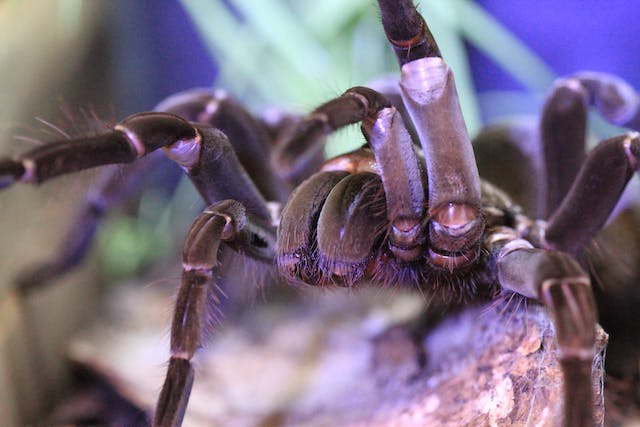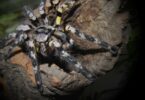Capturing stunning shots of tarantulas can be tricky. These eight-legged beauties move fast and often hide in dark corners. But don’t worry – with the right tips, you can snap amazing photos of these fuzzy creatures.
This guide will show you how to use your camera, lighting, and timing to get the best tarantula pictures. Get ready to level up your spider photography game!
Choosing the Right Equipment for Tarantula Photography
Picking the right gear can make or break your tarantula photos. A good macro lens and a steady tripod are key for sharp, detailed shots of these hairy spiders.
Selecting the Ideal Camera and Lens
For tarantula photos, you need a good camera and lens. A macro lens is ideal for close-ups. David Albaugh, a bug photographer, uses a Sigma 105mm lens on a Sony Alpha body. This setup costs about £500 if you buy used gear.
The macro lens allows you to focus up close and capture sharp details of the spider.
Your camera should have manual focus for the best shots. This helps you focus precisely on the tarantula’s eyes or other small parts. A digital SLR camera works well because you can change lenses.
Look for one with high ISO settings for low-light shots. Tarantulas often hide in dark places.
Benefits of Using Tripods and Remote Shutters
After picking the right camera and lens, you’ll want to add some key tools. Tripods and remote shutters can take your tarantula photos to the next level. A tripod keeps your camera steady, which is crucial for sharp images.
This is especially helpful when shooting in low light or using slow shutter speeds. Remote shutters let you take photos without touching the camera, reducing shake even more.
These tools give you more control over your shots. With a tripod, you can set up your camera and wait for the perfect moment. This is great for capturing natural behaviors of tarantulas.
Remote shutters allow you to snap photos from a distance, which is safer for you and less stressful for the spider. Together, tripods and remote shutters help you get clear, detailed photos of these amazing creatures.
Mastering Lighting Techniques for Tarantula Shots
Lighting makes or breaks tarantula photos. Good light shows off the spider’s colors and details.
A spider looks its best right after molt
Tarantulas shine after molting. Their colors pop and their markings stand out. This is the perfect time to snap photos. Fresh molts show off the spider’s true beauty. Captive-bred tarantulas are easier to shoot than wild ones.
They stay still longer, giving you more chances for great shots.
A freshly molted tarantula is a photographer’s dream.
Feeding time offers another good photo chance. Spiders often pause to eat, letting you capture clear images. Use a macro lens to get up close and show off the spider’s details. Next, we’ll look at how to light your eight-legged model.
Maximizing Natural Light
Natural light is key for great tarantula photos. Shoot during the golden hour, right after sunrise or before sunset. This soft light brings out the best in your eight-legged subject.
It creates a warm glow and gentle shadows that highlight the tarantula’s features.
Cloudy days offer another perfect chance for tarantula shots. The clouds act like a big diffuser, spreading light evenly. This soft light reduces harsh shadows and shows off the spider’s details.
Place your tarantula near a window or in a shaded outdoor spot for the best results.
Using Artificial Lighting to Enhance Details
Artificial lighting helps bring out the best in tarantula photos. You can use flash, adjust ISO, and change aperture to get great shots. These tools make the spider’s details pop. Reflectors and diffusers are handy too.
They help control shadows and bright spots. With the right setup, you can capture every hair on your tarantula’s legs.
Good lighting shows off a tarantula’s colors and textures. It’s key for macro shots of their eyes or fangs. You might need to try different light angles to avoid glare. Soft, even light works best for most tarantula portraits.
It brings out their unique beauty without harsh shadows.
Strategies for Capturing Tarantula Movement
Tarantulas move fast. You need quick reflexes to catch their sudden bursts of speed. Learn their habits and patterns to predict their next move.
Tips for Waiting for the Perfect Moment
Tarantula photography requires patience and timing. These tips will help you capture the perfect shot:
- Stay still and quiet. Tarantulas may freeze if they sense movement or vibrations.
- Watch for signs of activity. Look for leg twitches or body shifts that signal the spider may move soon.
- Use a remote shutter. This lets you take photos without touching the camera, reducing shake.
- Set up your shot in advance. Frame and focus before the tarantula moves into position.
- Take lots of photos. Shoot in burst mode to catch fleeting moments of action.
- Learn tarantula habits. Know when they’re most active to plan your photo sessions.
- Be ready after a molt. A freshly molted tarantula often looks its best for photos.
- Use a fast shutter speed. This helps freeze motion for crisp shots of moving spiders.
- Try different angles. Move around to find unique views of your eight-legged subject.
- Keep your camera ready. Have settings pre-adjusted so you can shoot quickly.
Understanding tarantula behavior is key to great photos. Let’s explore some insights that will improve your shots.
Insights into Tarantula Behavior for Better Photos
Knowing how tarantulas act helps you take better photos. These spiders often stay still while eating. This makes feeding time great for pictures. You can get clear shots of their face and legs.
Watch for when they molt too. Right after shedding, their colors look bright and fresh.
You can capture amazing close-ups of these special features. Use a macro lens to show off the details of their unique body parts.
Tackling Challenges in Tarantula Photography
Tarantula photography can be tricky. Low light and fast movements make it hard to get clear shots. But with the right tools and methods, you can snap amazing spider photos.
Handling Low Light Conditions
Low light can make tarantula photos tricky. But don’t worry! You can still get great shots. Use a wide aperture like f/2.8 to let in more light. This helps your camera see better in the dark.
Also, try using a flash. It can light up your spider friend and show off its cool details. Just be careful not to scare it!
Adjust your camera settings for the best results. Raise the ISO to make your camera more light-sensitive. Use a slower shutter speed to catch more light. But be careful – this might blur your photo if the spider moves.
A tripod can help keep things steady. With these tips, you’ll snap awesome tarantula pics even in dim light.
Managing Rapid Movements of Tarantulas
Tarantulas move fast, making them tricky to photograph. Use a quick shutter speed to catch their sudden moves. A speed of 1/250 or faster works well. Stay calm and keep your distance.
This helps you avoid startling the spider. It also gives you time to adjust your camera settings.
Patience is key when shooting shy tarantulas. Move slowly and quietly to avoid scaring them. Watch for signs that the spider is about to move. These can include leg twitches or body shifts.
Be ready to snap the photo at any moment. With practice, you’ll learn to predict their actions and get great shots.
Conclusion
Capturing stunning tarantula shots requires skill and patience. With the right gear and techniques, you can take amazing photos of these hairy spiders. Practice improves results, so keep trying new angles and lighting.
Be sure to respect the tarantulas and their habitat while you shoot. Your efforts will result in beautiful images that showcase these fascinating creatures.
FAQs
1. What camera is best for tarantula photos?
A DSLR camera works great for tarantula shots. It lets you control depth of field and focus. You can use macro lenses for close-ups of your spider friend.
2. How do I get clear tarantula pictures?
Use a low f-number for a shallow depth of field. This makes the spider stand out. Set your auto-focus on the tarantula’s eyes. Adjust exposure times to avoid blur.
3. What lighting helps with tarantula photos?
Natural light is often best. If indoors, use soft, diffused light. Avoid flash, as it can scare the spider. Good lighting helps show off the tarantula’s colors and details.
4. Can I take pictures of tarantulas in the wild?
Yes, but be careful. Wild tarantulas need respect. Use a long focal length lens to keep your distance. Always put the spider’s safety first. Ask an expert if you’re not sure.
5. How can I improve my tarantula photos after taking them?
Post-processing can help a lot. Adjust contrast to bring out textures. Crop the image to improve composition. Sharpen details like the spider’s hairs. But don’t overdo it – keep the photo looking natural.







